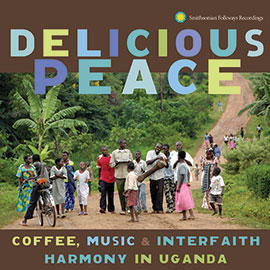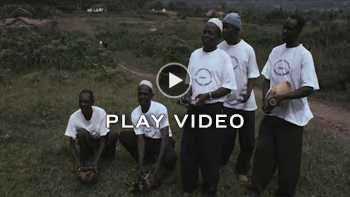Summary:
The Mirembe Kawomera Coffee cooperative in Uganda is a movement designed to promote the sale of Ugandan coffee, but also to unite several culture groups, including Christians and Muslims, to promote a common cause of world peace. ‘Mirembe’ means ‘peace’ and ‘kawomera’ refers to the high quality nature of the coffee that this co-op sells. As part of the world peace movement, members of this co-op came together to record a musical album. This lesson explores much of the music that is found on this album.
Suggested Grade Levels: 6–8, 9–12, college/university
Country: Uganda
Region: Eastern Africa
Culture Groups: Bagisu, Basoga, Bamasaba, Bugwere, Ganda
Genre: Interfaith
Instruments: Body percussion, jerrycan, vocals, akadongo, nsasi, endingidi, endongo, embaire
Languages: Swahili, Lugisu, Luganda, and Lugwere
Co-Curricular Areas: Social studies, economics, religious studies
National Standards: 1, 2, 6, 7, 9
Prerequisites: A basic knowledge of music theory is helpful for this lesson.
Objectives:
- Listen to music examples from the Mirembe Kawomera Coffee cooperative in Uganda
- Discuss the roles of music in the context of the cooperative
- Address the variety of musical styles, instruments, and languages used in the Delicious Peace compilation album
- Become familiar with common rhythmic patterns, melodies, and musical forms.
Materials:
- “Hit the Jerrycan!” (2006) by Integrated Rural Development Support Programs Choir from the album Delicious Peace: Coffee, Music & Interfaith Harmony in Uganda
- “Let All Religions Come Together” (2008) by Akuseka Takuwa Kongo Group from Delicious Peace
- “Abatuga abagalana” (1950) from the album Songs with endongo bowl lyre and a humorous song with drums from the Ganda of Buganda district (Central Province), Uganda
- “In Uganda everyone grows coffee” (2006) by the Mbiko Aisa Farmers Group from Delicious Peace
- Clip from the video “The Inspiration for Delicious Peace: Coffee, Music & Interfaith Harmony in Uganda”
- Photos from the article “Mirembe Kawomera (Delicious Peace) Coffee, Music and Interfaith Harmony in Uganda”
- Lyric transcriptions from Delicious Peace liner notes, also available on the Smithsonian Folkways website
Lesson Segments:
- “Hit the Jerrycan!” (National Standards 1, 2, 6, 9)
- “Let All Religions Come Together” (National Standards 1, 2, 6, 7, 9)
- “In Uganda, Everyone Grows Coffee” (National Standards 1, 2, 6, 7, 9)
1. “Hit the Jerrycan!”

Photos © Richard Sobol

Click image to read more.
“Hit the Jerrycan!”
from Delicious Peace: Coffee, Music & Interfaith Harmony in Uganda (2006) | SFW50417
- Clap along to “Hit the Jerrycan!” from approximately 3:45–4:45 (all subsequent activities refer to this section of the song).
- Notice two alternating body percussion sounds, one more muted than the other.
- While playing along to the clapping in the recording, use two different movements to reflect the sounds you hear. For example, alternate between clapping with palms together and clapping with the back of one hand to the palm of the other.
- Contextualize the song using video material from the Smithsonian Folkways website.
- Explain the theme of the album Delicious Peace (2012) and introduce the context of the coffee cooperative, Mirembe Kawomera.
- Watch a clip from the video “The Inspiration for Delicious Peace: Coffee, Music & Interfaith Harmony in Uganda” from 3:45–4:16.

Video: J.J. Keki Discusses inspiration behind Delicious Peace: Coffee, Music & Interfaith Harmony in Uganda. Click to watch video.
- The speaker in the video mentions that singing is used to promote the goals of the coffee cooperative, but it’s not obvious how the song “Hit the Jerrycan!” is connected to this theme. From this point on, we will try to understand the ways in which the song fits into the context of the cooperative.
- Listen to “Hit the Jerrycan!” and focus on the sound of the jerrycan.
- Ask: Based on listening, what kind of material do you think the jerrycan is made out of? (Plastic.)
- Show jerrycan photos from the Smithsonian Folkways Magazine article “Mirembe Kawomera (Delicious Peace) Coffee, Music and Interfaith Harmony in Uganda.”
- Ask: Based on the photos, how is the jerrycan played? (With bare hands.)
- Explain that the word akadomolo means “play the jerrycan.”
- Play along with the jerrycan. Do this by tapping quietly on a table or desk with both hands. Be sure to pay attention and follow along when the rhythm changes.
- Ask: How many rhythmic patterns can you identify? (Two main patterns.)
- Work on translating and understanding the lyrics.
- Ask: What is the form of the song? (Call-and-response.)
- Offer a translation of the main response line, Koona koona koona koona akadomolo, which means “hit, hit, hit, hit, play the jerrycan.”
- Explain that the song is used to welcome visitors who sponsor the coffee cooperative. Explore several lines of text from the solo singer and discuss why they fit the context as a welcome song (lyrics from Smithsonian Folkways website).
-
Nobwolaba nnyimba obutamala kulwange dance tendese.
You see me singing endlessly, that is because Kawomera didn’t abandon me.
Nobwolaba abigula obutamala kulwekyo Kawomera temumuleka.
You see her dancing endlessly, that is because you have not abandoned [Peace] Kawomera.
Nobwolaba adigida obutamala kulwekyo kawa tagyileka.
You see her shaking endlessly, that is because coffee didn’t abandon her.
Nobwolaba mmenyeka obutamala kulwekyo Kawomera temumulese.
You see me break dancing, it is because you didn’t abandon [Peace] Kawomera. - Ask: What activities do the lyrics describe? (Singing, dancing, shaking, break dancing.)
- Ask: What emotions does the song convey? (Joyful, thankful, celebratory.)
- Listen to the recording and sing along with the response line, Koona koona koona koona akadomolo.
Assessment:
- Students must be able to accurately sing along with the response line
- They must also be able to accurately tap the jerrycan rhythms or clap along in the same manner as the first exercise.
Lesson 2: “Let All Religions Come Together”

Video: "Let All Religions Come Together" by Akuseka Takuwa from Delicious Peace: Coffee, Music & Interfaith Harmony in Uganda. Click to watch video.
- Watch the video of the song “Let All Religions Come Together” on the Smithsonian Folkways website.
- Ask: Can you describe the different types of instruments you see and hear? (Three lamellophones (pitched instruments that are made of long, thin metal plates or ‘tongues’), fiddle, shaker, and vocals.)
- Introduce the traditional instruments featured in the song: akadongo (lamellophone), endingidi (one-string tube fiddle), and nsasi (shaker).
- Ask: What interesting playing technique does one of the seated akadongo players use? (Knocks on the sound board while playing, shown in 2:15–2:35.)
- Watch a clip of the video from 2:45–3:00 and notice the metal bands attached to the tops of the keys of the akadongo. Ask: What purpose do these serve? (Buzzing timbre, helps to amplify the instrument.)
- Listen to the track “Let All Religions Come Together” from the Delicious Peace album and tap along to the main beat played by the nsasi.
- As you tap along, think about how the endingidi player interacts with the main beat. (Endingidi subdivides the pulse into triplets.)
- Listen again from 0:50–1:30 and sing along quietly on doh to what sounds like ”quarter note” triplet chords played on the akadongo.
- Ask: What basic repeated pattern do you hear throughout the song? (Four sets of triplets –with rhythmic variations—make up the cycle. The pattern is close to C# C# C#, B B B, C# C# C#, A A.)
- Listen again and ask half of the class to tap the main pulse while the other half of the class sings along with the akadongo.
- Ask: When do they align? (Third note of the triplet on beat 3 of the main pulse if you describe the song in a 12/8 meter.)
- Ask: How does the singer interact with the akadongo pattern? (In some instances, the singer and akadongo chords complement one another through call and response. Other times they are heard together as the vocalist sings the same melodic and rhythmic pattern as the akadongo.)
- Explore the context of the song.
- Watch “The Inspiration for Delicious Peace: Coffee, Music & Interfaith Harmony in Uganda.”
- Ask: What is the significance of “Let All Religions Come Together” in the context of the coffee cooperative, Mirembe Kawomera? (The cooperative began in order to build a financially successful and sustainable interfaith community.)
- Ask: Based on what you learned from the video, why is it important to promote “interfaith harmony” through song in this context? (Music helps promote and reinforce interfaith harmony and a sense of community through participatory music making.)

Click image to read more.
“Abatuga abagalana”
from Songs with endongo bowl lyre and a humorous song with drums from the Ganda of Buganda district (Central Province), Uganda (1950) | ILAMTR136B
- Listen to “Abatuga abagalana” (1950) from Smithsonian Folkways and compare the song with “Let All Religions Come Together” (2008).
- Introduce the recordings by explaining that they are from regions in Eastern and Central Uganda that feature the endingidi. They are different in that the field recording from 1950 is played by the Ganda and sung in the same language. The Delicious Peace liner notes explain how “Let All Religions Come Together” was recorded in 2008 and sung in Lugwere in the traditional style of the Bagwere.
- Ask: What obvious differences and similarities do you hear in the two tracks? (The 1950 recording includes the distinct sound of the endongo lyre and doesn’t have akadongo or nsasi. Both songs have the endingidi and a male vocalist.)
- Listen to a thirty-second clip of each song and tap along to the main pulse each time. Ask: How would you compare the sounds of the endingidi and the vocals on the two tracks? (The endingidi plays a repeated pattern in both songs but in a somewhat faster tempo on the 1950 recording. The vocals on “Abatuga abagalana” are also more speech-like in comparison to the melodic lines of “Let All Religions Come Together.”)
Assessment:
Students are asked to either bring in a piece of music that demonstrates the ideals of interfaith harmony or to create their own song that demonstrates interfaith harmony. They should be able to give a detailed explanation of why they chose the song that they did and be able to supply examples that support their aim to promote interfaith harmony through song.
Lesson 3: “In Uganda, Everyone Grows Coffee”
- Listen to “In Uganda Everyone Grows Coffee” from 1:15–1:50 and tap along to the main beat.
- Ask: What instruments do you hear in the recording? (Embairexylophone, shaker, solo singer and chorus)
- Listen again to the same clip and hum along to the melody of the response line, Lero tulima mwanyi, meaning “Nowadays, we grow coffee” in Lugwere.
- Explore the context of the song.
- Watch “The Inspiration for Delicious Peace: Coffee, Music & Interfaith Harmony in Uganda” from 3:15–7:30.
- Ask: How is music used in the context of the coffee cooperative? (To draw new members into the cooperative, to teach people how to grow coffee, to build a sense of community through song based on mutual interests.)
- Take a moment to look at the lyric translations of “In Uganda, Everyone Grows Coffee” available on the Smithsonian Folkways website. Ask: Based on the lyrics and what you learned from the video, what is the significance of the song “In Uganda Everyone Grows Coffee”? (The song promotes the idea that the coffee business is accessible to anyone who wants to participate, and it emphasizes the success of the business based on its growing popularity. The lyrics also reinforce a sense of group identity as coffee growers.)
- Learn about the embaire xylophone instrument.
- Read the paragraph in the liner notes (under the song title) about the instrument to learn more about its construction, its appeal, and its relationship to popular music in traditional contexts.
- Listen to “In Uganda Everyone Grows Coffee” and focus on the sound of the embaire as you tap along to the main beat.
- Ask: How many beats constitute one cycle of the embaire pattern? (There are sixteen beats in one complete cycle. This may be misleading at first since there is only a slight difference between the first and second halves of this cycle. The highest note in the second half of the cycle is a whole step higher than the highest note in the first half of the cycle.)
- Listen carefully and ask half the class to quietly tap the pattern of the embaire while the other half of the class taps the main pulse of the song.
- Ask: Can you hear the repeated notes played on the embaire? How do you think this is accomplished? (Two or more players will often sit on opposite sides of the instrument, striking the ends of the keys rather than the tops of the keys and play hocketing, or interlocking, melodies.)
- Transfer the embaire pattern to a xylophone or marimba using the following basic pattern as a guide:

- Optional: slow down the tempo and attempt to hocket the embaire line using two xylophones or marimbas so the second instrument follows the first. The two instruments together should create the following line, where every other note is played by the same person:

- While two or more students play the embaire lines on marimba or xylophone, ask the rest of the class to clap along with the main pulse or sing the vocal response line on la.
Assessment:
- By the end of this lesson, students should be able to successfully play both melodies on a xylophone or a marimba
- Students who are seeking to be challenged should be able to play their part while another student is playing the opposite part – creating a hocket melody






